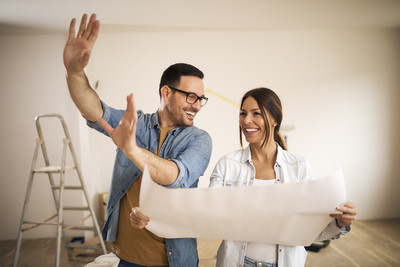Home improvements and overcapitalisation
Written and accurate as at: Oct 19, 2020 Current Stats & Facts

According to the latest data from the Australian Bureau of Statistics*, when it comes to household wealth:
1. Owner-occupied dwellings are the largest asset held by households, representing a value of $500,600 when averaged across all households, and accounting for 42% of household assets. Super is the second-largest household asset overall, and the largest financial asset, averaging $213,700 per household across all households, and accounting for 18% of household assets.
2. Other than their primary place of residence, around one in five households own other property including residential and non-residential property for rent, and holiday homes. The value of property (other than the home) averaging $180,400 across all households, and accounting for 15% of total assets.
When it comes to building and maintaining household wealth—especially in terms of buying and selling residential property as an owner-occupier and investor—there are many key things to consider.
One such consideration can centre on property value and improvements, and overcapitalisation. Please note: While this article primarily focuses on owner-occupiers, what’s covered may also be of relevance to investors.
Home value
The value of your home can be influenced by many factors. One such factor is the location of your home, which can encompass the city and region, suburb and street, and land ‘position and site’.
Although, it must be noted that the location of your home can be somewhat fixed unless there is, for example:
- a change in land subdivision rulings,
- a proposed nearby residential, commercial/retail development, or
- an expected population increase coupled with a surge in property demand.
These things are predominantly out of your control. However, there are things you can do in terms of the value of your home, be it in relation to increasing the value of your home for resale, or purely for lifestyle (liveability) reasons, for example:
- making improvements to modernise your home,
- keeping up with the required repairs and maintenance, and
- enhancing the ‘aesthetic appeal’ that gives your home a point of difference.
However, in terms of the first (and third) point, it can be important to consider your ‘return on investment’.
Home improvements
When it comes to Australians and our continued interest in home improvements, an example of this may be the many reality TV shows including, House Rules, The Block, Grand Designs Australia, Fixer Upper, House Hunters Renovations, Selling Houses Australia, and Love It Or List It.
In addition, a recent survey by Roy Morgan Research^ found that approximately 8.4 million (62%) of Australia’s 13.6 million home-owners^ undertook some kind of home improvement in 2016, up from around 7.5 million (57%) in 2013.
^Home-owners classified as being those Australians who either own their home outright or are paying it off.
Importantly, across all sub-groups (except the installation of insulation), home improvements were up in 2016, compared to 2013. For further insights from the Roy Morgan Research survey please see the below table.
|
Home improvements done by Australian home-owners: 2013 vs 2016
|
||
|
Home improvements |
2013* |
2016* |
|
Did some renovations |
7,509,000 |
8,393,000 |
|
Made minor repairs/alterations around home |
5,145,000 |
5,836,000 |
|
Painted wall/ceiling/window sills – inside/outside |
3,466,000 |
3,714,000 |
|
Spent money on plumbing work at home |
2,844,000 |
3,379,000 |
|
Spent money on electrical work at home |
2,874,000 |
3,379,000 |
|
Redecorated/refurbished home in some way (e.g. curtains, carpet, wallpaper) |
2,674,000 |
2,928,000 |
|
Spent over $5,000 renovating/extending home |
1,946,000 |
2,254,000 |
|
Installed insulation in home |
516,000 |
479,000 |
*The number of home-owners who did each kind of home improvement.
As previously mentioned, the reason behind a home improvement can often fall into one of two categories, those done to increase the value of the home for resale (or rentability), or for lifestyle (liveability) reasons.
Home overcapitalisation
From a return on investment perspective, it’s important to note that when spending money on home improvements, the value of your home may not automatically increase by the amount you spend.
For example, if you purchased your home for $804,602# and now intend to spend $150,000 on home improvements, this won’t necessarily mean the value of your home will be $954,602.
In some instances, you may lose money by overcapitalising on your investment—improving your home beyond its resale value. This can be an especially important point if you are looking to sell your home in the short-term^.
As a general rule of thumb, neighbourhoods (and areas) can frequently have what’s referred to as a ‘ceiling value’, and trying to increase your home’s value above this ceiling can often result in diminishing returns.
Therefore, if your home’s current value is $804,602 and the average market value for the neighbourhood (and area) is $854,602, consider exercising caution if you intend to spend in excess of $50,000 on home improvements.
Another consideration can relate to specific building features. For example, installing a swimming pool or adding expensive fixtures and fittings that are out of step with neighbouring houses may also lead to overcapitalisation.
After reading this article, you may also find the following of interest:
- property selling costs,
- DIY renovation project considerations,
- seven things to consider before you renovate,
- tips for working out the value of your home when selling, and
- residential investment properties and income-generation considerations.
If you have any questions regarding this article, please contact us.
*Australian Government, Australian Bureau of Statistics. (2019). Household Income and Wealth, Australia.
^Roy Morgan, Roy Morgan Research. (2017). Renovation Nation: home improvement in Australia.
#Domain. (2020). Domain June House Price Report.











